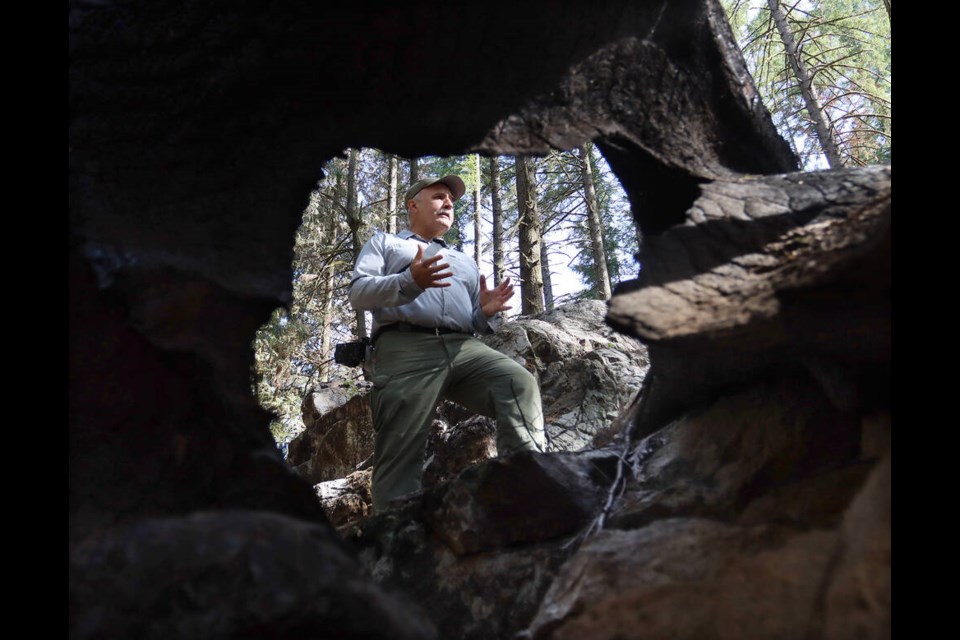"It could have been worse."
That’s the conclusion of a Metro Vancouver parks biologist surveying the devastation left by last October’s human-caused fire in Minnekhada Regional Park in Coquitlam.
The damage is still evident in charred remains of toppled trees, singed trunks and burned root systems that look like gnarled limbs against a blue sky.
Markus Merkens, Metro Vancouver’s natural resource management specialist, considers the blackened debris left by the blaze and says he sees mostly signs of nature’s resilience.
He points to ferns that have produced new shoots, salal plants peaking out from the dirt, brash maple seedlings taking root and stately purple fireweed that has popped up since the spring.
“Nature has a reserve,” said Merkens, “You have to see post fire as a period of renewal. It’s not all devastation.”
The contrast between the trail leading up to High Knoll and the rocky face of the look-out is stark.
Most of the trail from Quarry Road parking lot up the final incline is green and there is the sounds of birds calling. Along the way one has to be careful of thousands of toadlets scrambling across the path to safety.
But near the top of the High Knoll trail, the forest looks somewhat bare, the bedrock is more exposed and there are stumps with signs of recent burns, although some of the older Douglas fir trees show burn marks from a forest fire that must have occurred a hundred years ago.
Still, as Merkins points out, it’s not all bleak. In one area atop some bedrock, a meadow of green has emerged.
Nature gets some help
Nature is also getting some help from Metro Vancouver Regional Parks Foundation, which has been raising funds for recovery.
Native seedlings are being planted in areas where firefighters worked and Metro Vancouver has been taking down hazardous trees.
Merkens said the work is to help nature recover not make big changes to the park.
“Nature provides with a lot of what we need to survive. If what we’ve done effects it, we are responsible for trying to keep it going.”
However, it seems some have taken matters into their own hands.
Packets of wildflower seeds have been dropped onto the High Knoll look-out, which could potentially become invasive or draw pollinators away from the forest’s native plants.
“There’s a patch of fireweed, that’s what we want to see grow,” said Sam Cousins, who is a natural resource management technician for Metro Vancouver.
Special event planned
Worried about the impact of the imported plants onto the ecosystem, Cousins pulled out the colourful flowers, which included California poppies and bachelor buttons — both not native to the park.
While trail runners and hikers have already been tracing the burn line with energetic bursts up the hill to High Knoll, most don’t stop to see how nature is starting to reclaim the area.
This summer, the public can get a closer look at the regeneration through a Minnekhada park interpretation program, led by Madeleine Irving-Chan.
The Hope in the Forest programs take place in July and August, with another likely in September. (Find out more under events at metrovancouver.org.
The public can also participate in a citizen science project to document with photos on social media the changes the park is going through after the fire. Look for a sign near the top of High Knoll where you can put your camera in a bracket, take a photo, and post it to Twitter or Instagram using the hashtag #Minfire02.
Fire risk is high
The fire burned through 14 hectares (0.14 sq-km.) of the park in Coquitlam, amid unusually hot and dry conditions last October.
Likely started by someone who threw something burning off the rocks atop High Knoll Trail, the blaze quickly flared up the cliff, cutting through gullies and eating into the forest.
Without determined action by firefighters, the fire could have spread to more areas of the park, said Merkens. Now the concern is that another fire could start in the park with ongoing hot, dry conditions.
“These parks are still vulnerable to fire and people shouldn’t do things that could put it at risk, such as smoking and campfires.”





